
When it comes to roofing solutions, the market offers a plethora of options, but among the most popular are EPDM, TPO, and PVC shingle ply roofing membranes. Each type comes with its own set of advantages and considerations, catering to different needs and preferences. In this srtudy, we’ll delve into the characteristics, best use cases, cost considerations, and pros and cons of each type, ultimately advocating for TPO as the superior choice.
EPDM (Rubber) – components are bonded together with adhesives.
EPDM roofing membranes have been a staple in the roofing industry for decades. Made from synthetic rubber, EPDM offers durability and flexibility, making it suitable for various climates.

Its best use cases include low-slope roofs, particularly in commercial and industrial settings. Cost considerations for EPDM typically fall in the mid-range category. Other advantages of EPDM include its resistance to UV radiation and ozone, as well as its ease of installation. However, it’s important to note that EPDM membranes are prone to punctures and can be less resistant to chemicals compared to other options.
Although rubber roofing has been on the market for more than fifty years, it has several critical downsides when compared to the unmatched performance of TPO. EPDM membranes shrink roughly three times the amount when compared to TPO roofing, putting added stress on the membrane and roofing system. Additionally, a rubber roof is essentially taped together using special tapes, primers, and adhesives. These connections are 75% less strong when compared to hot air welded single ply membrane like TPO and PVC.
PVC (Polyvinyl Chloride) – components are hot-air welded using heat guns. PVC membranes weldable roofing membranes just as the case with TPO roofing. They are known for their strength, durability, and energy efficiency and they’re highly reflective, making them ideal for buildings in hot climates where reducing cooling costs is a priority. 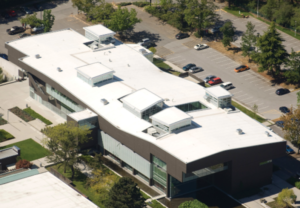 PVC membranes are often used in commercial roofing applications and in most cases if PVC is selected, it is chosen due to its unique chemical resistance and is more tolerant to grease, smoke and other chemicals that come into contact with its surface. In terms of cost, PVC tends to be on the higher end of the spectrum. While the initial investment may be higher, PVC’s long lifespan and energy-saving properties can result in significant savings over time. Advantages of PVC roofing include its ability to withstand extreme weather conditions however, PVC membranes may become brittle over time and are not as environmentally friendly as some other options due to the use of plasticizers in their manufacturing process.
PVC membranes are often used in commercial roofing applications and in most cases if PVC is selected, it is chosen due to its unique chemical resistance and is more tolerant to grease, smoke and other chemicals that come into contact with its surface. In terms of cost, PVC tends to be on the higher end of the spectrum. While the initial investment may be higher, PVC’s long lifespan and energy-saving properties can result in significant savings over time. Advantages of PVC roofing include its ability to withstand extreme weather conditions however, PVC membranes may become brittle over time and are not as environmentally friendly as some other options due to the use of plasticizers in their manufacturing process.
TPO (Thermoplastic Polyolefin) components are hot air welded using heat guns.
Now, let’s turn our attention to TPO roofing membranes, which have gained popularity over the past fifteen years due to their numerous advantages. TPO offers the best of both worlds, combining the durability of EPDM with the energy efficiency of PVC. Moreover, TPO has hot air welded seams just a PVC membranes but is twenty to thirty percent less for the materials of when contrasted with rubber and PVC. 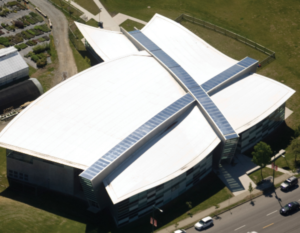 Cost considerations for TPO typically fall in the mid to high range, but its superior performance and longevity justify the investment. TPO roofs are known for their white reflective surface, which helps reduce cooling costs by reflecting sunlight away from the building. Advantages of TPO roofing are abundant. It boasts excellent weather resistance, including resistance to UV radiation, ozone, and chemical exposure. TPO membranes are also highly flexible and resistant to punctures, making them easy to install and maintain. Additionally, TPO is considered more environmentally friendly than PVC due to its lack of plasticizers. They are easier to install and less prone to human error during the process due to their ease of weldability. There’s a reason why TPO has emerged as the number one low-slop single ply membrane and is specified on new construction blueprints across the nation.
Cost considerations for TPO typically fall in the mid to high range, but its superior performance and longevity justify the investment. TPO roofs are known for their white reflective surface, which helps reduce cooling costs by reflecting sunlight away from the building. Advantages of TPO roofing are abundant. It boasts excellent weather resistance, including resistance to UV radiation, ozone, and chemical exposure. TPO membranes are also highly flexible and resistant to punctures, making them easy to install and maintain. Additionally, TPO is considered more environmentally friendly than PVC due to its lack of plasticizers. They are easier to install and less prone to human error during the process due to their ease of weldability. There’s a reason why TPO has emerged as the number one low-slop single ply membrane and is specified on new construction blueprints across the nation.
Attachment Methods for Single Ply Membranes
When reroofing up building it is important to understand the three types or “methods of installation” of single ply membranes. There are three ways a membrane can be installed: adhered, mechanically fashioned, or ballasted. These attachment methods are just as they sound and can be put in simply as “glued down,” “screwed down,” and “weighed down.” Although many would agree that no one particular system necessarily better than another in terms of use cases since they each have their place in the marketspace but one would have a hard time finding anyone who would argue that the latter two attachment methods are superior to an adhered membrane. Adhering a membrane has three downsides: cost, increased installation time, and odors entering the building. The benefits of an adhered membrane include an increased wind rating reducing the likelihood of sheets blowing off with wind gusts greater than 90 mph, a reduction in stress placed on the membrane itself as the sheets naturally shrink over time and a better-looking finished product.
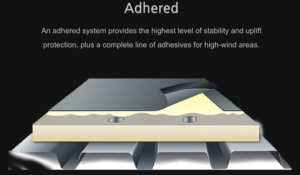 Fully adhering a single ply membrane in place is time-consuming due to the flash off/dry times required during installation. Also, when adhering a membrane to any recovery board/insulation board, increased number of fasteners and hardware are required prior to attaching these boards to the structure. This is largely due to the fact that as a single pie member in shrinks over its life, greater surface tension is placed on the recovery boards and if omitted, cupping and curling to the insulation will occur causing undesirable ponding water, reducing insulation performance and increasing the likelihood of high-speed wind damaging the roofing system.
Fully adhering a single ply membrane in place is time-consuming due to the flash off/dry times required during installation. Also, when adhering a membrane to any recovery board/insulation board, increased number of fasteners and hardware are required prior to attaching these boards to the structure. This is largely due to the fact that as a single pie member in shrinks over its life, greater surface tension is placed on the recovery boards and if omitted, cupping and curling to the insulation will occur causing undesirable ponding water, reducing insulation performance and increasing the likelihood of high-speed wind damaging the roofing system.
A mechanically fastened single ply membrane is just as it sounds and involves using specially engineered screws and other hardware components to pin and attach the sheets in place. Think of mechanically fastening a membrane as using a flat piece of metal and a screw to disperse attachment pressure more evenly across a membrane. Typically, when single ply membranes are mechanically fastened to a roof deck, the fasteners are selected based on the deck type (metal or wood) along with the length being determined by the overall thickness of the insulation and or the additional roofing system layers installed over the substrate. The screws need to be sufficient in length to penetrate the roof deck. Additionally, screws need to be stronger when attaching to metal decking and the threads on the screws need to be deeper. This is due to the fact that as a metal deck undergoes normal expansion contraction with thermal changes, the likelihood of screws migrating upward is increased if the threads of the screws selected are not deep enough to bite into the metal. If the wrong screws are used, these fasteners can migrate upward and eventually rub through the underside of the membrane causing leaks. Also used in conjunction with commercial roof screws are hard work components such as “inseam batten strips” and “barbed plates.” During installation, membrane is unrolled and cut to the desired length. Barb plates or batten strips are placed along the edge lengthwise and screws are driven through them, applying compression to the hardware component and intern applying compression to the membrane holding it in place. The fasteners are typically spaced 12 inches apart from one another and once in entire line of membrane has been secured in place, the next subsequent course of material is lapped over the screws and plates used for the previous course and then connected together accordingly depending upon the single ply membrane chosen. 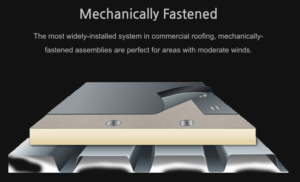 If mechanically fastening a single ply membrane is desired, the membrane chosen must be reinforced with nylon scrim built into the thickness of the sheets. This is because over time, all membranes shrink in size, putting stress on the membrane. Mechanically fastening a non-reinforced EPDM sheet will fail due to the pressure placed on the membrane at the points where screws are driven through the sheets. Rolls of rubber roofing are available in both non-reinforced and reinforced but if mechanically fastening, a reinforced sheet must be used to avoid problems.
If mechanically fastening a single ply membrane is desired, the membrane chosen must be reinforced with nylon scrim built into the thickness of the sheets. This is because over time, all membranes shrink in size, putting stress on the membrane. Mechanically fastening a non-reinforced EPDM sheet will fail due to the pressure placed on the membrane at the points where screws are driven through the sheets. Rolls of rubber roofing are available in both non-reinforced and reinforced but if mechanically fastening, a reinforced sheet must be used to avoid problems.
The third way that a single ply membrane can be installed is a ballasted system. A ballast is a fancy way of saying gravel. This system has been used for decades mainly due to the lower costs associated with such a system but there are a few other reasons why building owners choose a ballasted single ply roofing system. Namely, blowing a ballast over the surface of a roof is an excellent way to improve fire retardance and is also a great way to reduce the likelihood of blowoffs from heavy winds. There’s also the added thermal benefit since a ballast reduces heat retention in the summer and minimizes heat loss in cold weather. Another instance where a ballasted single ply system makes sense is if they existing building has a specialty deck type. From the 1940’s and onward, there were two other deck types that made it to the market and those were concrete-based structural products and Tectum®. 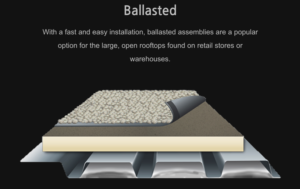 This new innovation gave rise to these engineered products, and they can still be found installed on buildings across the US. Both former deck types pose an additional challenge since traditional screws will not bite into them, leaving building owner who have these existing deck an expensive decision to make. That is, a costly fully adhered system and all the components that work in conjunction with adhering insulation or costly labor-intensive fastening using specially engineered auger screws with deep threads. These roofs are assembled similarly to the adhered and mechanically fastened systems, but the membrane is only anchored to the structure at the perimeter and at the penetrations protruding through the roof such as plumbing vent pipes and other mechanical curbs. All courses of membrane are attached to one another and then a ballast is blown in place with special equipment to weigh the membrane down. As of the 2010’s, most manufacturers require “slip sheet” be laid over the new membrane to prevent any sharp edges of the gravel from puncturing it or rubbing through the sheets if a building owner wishes to obtain a total system warranty. This added requirement is not cheap and thus, the ballasted roofing days have largely been abandoned and replaced with a mechanically fastened system.
This new innovation gave rise to these engineered products, and they can still be found installed on buildings across the US. Both former deck types pose an additional challenge since traditional screws will not bite into them, leaving building owner who have these existing deck an expensive decision to make. That is, a costly fully adhered system and all the components that work in conjunction with adhering insulation or costly labor-intensive fastening using specially engineered auger screws with deep threads. These roofs are assembled similarly to the adhered and mechanically fastened systems, but the membrane is only anchored to the structure at the perimeter and at the penetrations protruding through the roof such as plumbing vent pipes and other mechanical curbs. All courses of membrane are attached to one another and then a ballast is blown in place with special equipment to weigh the membrane down. As of the 2010’s, most manufacturers require “slip sheet” be laid over the new membrane to prevent any sharp edges of the gravel from puncturing it or rubbing through the sheets if a building owner wishes to obtain a total system warranty. This added requirement is not cheap and thus, the ballasted roofing days have largely been abandoned and replaced with a mechanically fastened system.

